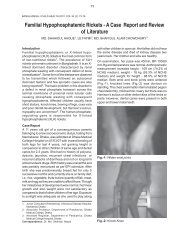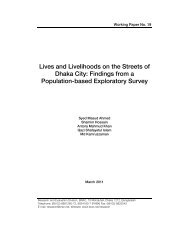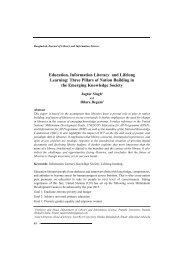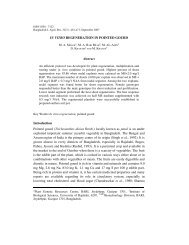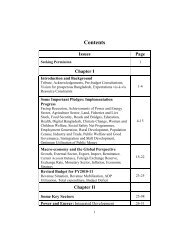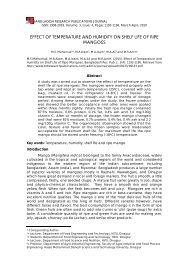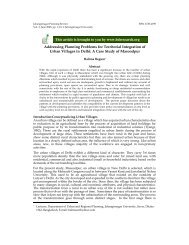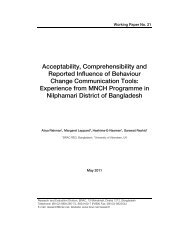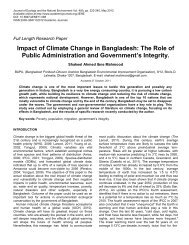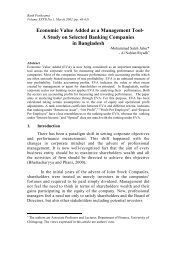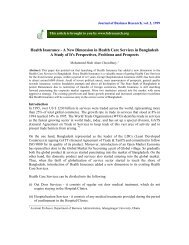Studies on Policy Option for Quality Seed Production and ... - NFPCSP
Studies on Policy Option for Quality Seed Production and ... - NFPCSP
Studies on Policy Option for Quality Seed Production and ... - NFPCSP
You also want an ePaper? Increase the reach of your titles
YUMPU automatically turns print PDFs into web optimized ePapers that Google loves.
Table 4.2.5 Services received from GO/NGOs <strong>for</strong> wheat grain/seed producti<strong>on</strong>at the study areasOrganizati<strong>on</strong>Large Medium Small Average% of farmers received serviceType of serviceRajshahiDAE 37 41 15 31 Advice, inputs, trainingNGO 0 12 7 6 Credit <strong>and</strong> inputs, trainingTotal 37 53 22 37 -DinajpurDAE 24 17 11 17 Advice, some inputsNGO 0 9 9 6 Credit <strong>and</strong> inputs, trainingTotal 24 26 20 23 -RangpurDAE 27 21 8 19 Advice, inputs, trainingNGO 0 15 10 8 Credit <strong>and</strong> inputs, trainingTotal 27 36 18 27 -Av (all sites) 29 38 20 294.2.7 Major cropping patterns practiced by the wheat farmersThe major wheat based cropping patterns practiced by the wheat farmers were: Wheat–T.aus–Fallow,Wheat–Fallow–Tomato, Wheat–Fallow–T.aman, <strong>and</strong> Wheat–T.aus–T.aman. In Dinajpur the patternswere: Wheat–Fallow–Rice, Wheat-Mungbean-T.aman, <strong>and</strong> Wheat–Jute–Rice <strong>and</strong> in Rangpur thepatterns were, Wheat-Jute–T.aman, Wheat–Fallow–T.aman, <strong>and</strong> Wheat-Mungbean-T.aman (Table4.2.6). From the table it is observed that the wheat crop was mainly sown after harvest of T.aman rice atall the sites <strong>and</strong> this c<strong>on</strong>flicts with the timely sowing of wheat. There<strong>for</strong>e as per the claims of thefarmers, short durati<strong>on</strong> T.aman rice varieties should be introduced to these areas <strong>for</strong> allowing timelysowing of wheat.Table 4.2.6 Major cropping patterns followed by the wheat farmers at the study areasMajor cropping patternsRajshahi Dinajpur RangpurWheat-T.aus-FallowWheat-Fallow-TomatoWheat-Fallow-T.amanWheat-T.aus-T.amanWheat–Fallow–T.amanWheat-Mungbean-T.amanWheat–Jute–T.amanWheat–Jute–T.amanWheat–Fallow–T.amanWheat-Mungbean-T.aman4.2.8 Time line of wheat cultivati<strong>on</strong>Time line of wheat producti<strong>on</strong> in Rajshahi shows that during 1983 the farmers of the study area used tocultivate three varieties like S<strong>on</strong>alika, Kanchan <strong>and</strong> Balaka. It is evident from the Table 4.2.7 that theyield of these three varieties was 3.0-3.5 t/ha. During 2008s, two new varieties Gourab <strong>and</strong> Shatabdiwere introduced. With the introducti<strong>on</strong> of new varieties the yield also increased to 4.5-5.0 t ha -1 .Farmers of the surveyed village in Dinajpur adopted HYV variety S<strong>on</strong>alika from the year 1984. Theyhad started growing another HYV variety named Kanchan from 1987, which persisted <strong>for</strong> a decade.Thereafter, farmers had adopted Shatabdi <strong>and</strong> Prodip & Bijoy from the year 2005 <strong>and</strong> 2007,respectively (Table 4.2.7). Farmers began to grow `Swarna’ (it is named ` Helna’ in India meaning53



